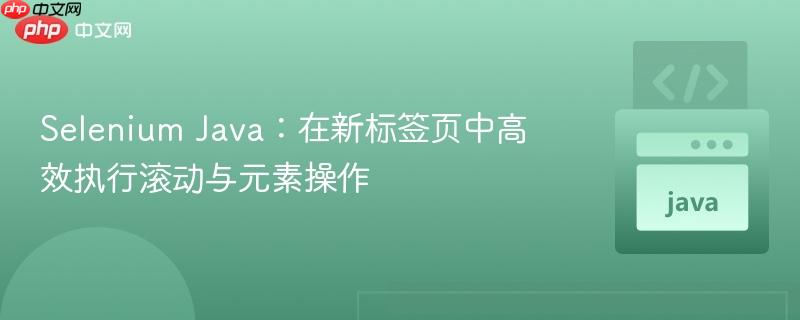
针对selenium java自动化测试中,当新标签页打开后,滚动和元素交互代码失效的问题,本文详细讲解了如何通过窗口句柄切换,将webdriver的控制权转移到新标签页。文章涵盖了获取所有窗口句柄、识别并切换到目标新标签页、以及在新标签页上成功执行页面滚动、元素查找与点击等操作,并提供了综合代码示例及最佳实践,确保自动化流程的连贯性与准确性。
理解Selenium在新标签页中的挑战
在使用Selenium进行Web自动化测试时,一个常见的场景是点击某个链接或执行某个操作后,浏览器会打开一个新的标签页或窗口。此时,如果直接尝试在新打开的标签页上执行滚动、查找元素或点击等操作,往往会发现这些操作无效或抛出NoSuchElementException。
这是因为WebDriver的控制权默认停留在执行操作之前的原始标签页上。当新的标签页打开时,WebDriver并不会自动将焦点切换过去。因此,所有后续的自动化指令仍然会尝试在旧的(当前活动的)标签页上执行,导致对新标签页的操作失败。要解决这个问题,核心在于明确地将WebDriver的控制权切换到新打开的标签页。
核心解决方案:窗口句柄切换
Selenium通过“窗口句柄”(window Handle)来唯一标识每一个浏览器窗口或标签页。要与新标签页进行交互,我们需要执行以下步骤:
- 获取所有窗口句柄: 在新标签页打开之前和之后,获取当前所有打开的浏览器窗口/标签页的句柄集合。
- 识别新标签页: 通过比较新旧句柄集合,找出新增加的那个句柄,它就代表了新打开的标签页。
- 切换到新标签页: 使用driver.switchTo().window(handle)方法,将WebDriver的控制权转移到新标签页。
以下是切换到新标签页的基本代码示例:
立即学习“Java免费学习笔记(深入)”;
import org.openqa.selenium.WebDriver; import Java.util.Set; import java.util.Iterator; public class WindowHandleswitching { public static void switchToNewTab(WebDriver driver, String originalWindowHandle) { // 获取所有当前打开的窗口句柄 Set<String> allWindowHandles = driver.getWindowHandles(); String newWindowHandle = null; // 遍历所有句柄,找到新标签页的句柄 for (String handle : allWindowHandles) { if (!handle.equals(originalWindowHandle)) { newWindowHandle = handle; break; // 找到新标签页后退出循环 } } if (newWindowHandle != null) { // 切换到新标签页 driver.switchTo().window(newWindowHandle); System.out.println("已成功切换到新标签页,URL: " + driver.getCurrentUrl()); } else { System.out.println("未能找到新标签页。"); } } }
在新标签页中执行页面操作
一旦WebDriver成功切换到新标签页,您就可以像操作原始标签页一样,在新标签页中执行各种自动化任务,包括页面滚动、元素定位和交互等。
页面滚动
页面滚动通常通过JavaScriptExecutor接口来完成。它允许您在浏览器上下文中执行JavaScript代码。
import org.openqa.selenium.JavascriptExecutor; import org.openqa.selenium.WebDriver; public class PageScrolling { public static void scrollPage(WebDriver driver, int yOffset) { JavascriptExecutor JS = (JavascriptExecutor) driver; // 向下滚动指定像素 js.executeScript("window.scrollBy(0, " + yOffset + ");"); System.out.println("页面已向下滚动 " + yOffset + " 像素。"); } public static void scrollIntoView(WebDriver driver, WebElement element) { JavascriptExecutor js = (JavascriptExecutor) driver; // 滚动到指定元素可见 js.executeScript("arguments[0].scrollIntoView(true);", element); System.out.println("页面已滚动到指定元素可见。"); } }
元素定位与交互
在新标签页中,元素的定位方式与在主标签页中完全相同,可以使用By.id、By.name、By.xpath、By.cssSelector等方法。
import org.openqa.selenium.By; import org.openqa.selenium.WebDriver; import org.openqa.selenium.WebElement; public class ElementInteraction { public static void clickElement(WebDriver driver, By locator) { WebElement element = driver.findElement(locator); element.click(); System.out.println("已点击元素: " + locator.toString()); } }
综合代码示例:从打开新标签页到操作
以下是一个完整的Java Selenium示例,演示了如何在一个网站上进行搜索,然后模拟打开一个新标签页,并切换到新标签页执行滚动和点击操作。
import org.openqa.selenium.By; import org.openqa.selenium.JavascriptExecutor; import org.openqa.selenium.Keys; import org.openqa.selenium.WebDriver; import org.openqa.selenium.WebElement; import org.openqa.selenium.chrome.ChromeDriver; import org.openqa.selenium.support.ui.ExpectedConditions; import org.openqa.selenium.support.ui.WebDriverWait; import java.time.Duration; import java.util.Set; public class NewTabScrollAndClickTutorial { public static void main(String[] args) { // 设置ChromeDriver路径 System.setProperty("webdriver.chrome.driver", "C:pathtochromedriver.exe"); // 请替换为您的ChromeDriver实际路径 WebDriver driver = new ChromeDriver(); // 使用显式等待,设置最大等待时间为10秒 WebDriverWait wait = new WebDriverWait(driver, Duration.ofSeconds(10)); try { driver.manage().window().maximize(); // 最大化浏览器窗口 driver.get("https://www.hepsiburada.com/"); // 导航到目标网站 // 1. 接受Cookie弹窗 wait.until(ExpectedConditions.elementToBeClickable(By.xpath("//button[text()='Kabul Et']"))).click(); // 2. 搜索商品 WebElement searchInput = wait.until(ExpectedConditions.visibilityOfElementLocated(By.xpath("//input[@class='desktopOldAutosuggestTheme-UyU36RyhCTcuRs_sXL9b']"))); searchInput.sendKeys("HBCV00000ODHHV"); searchInput.sendKeys(Keys.ENTER); // 3. 记录原始窗口句柄,准备模拟新标签页的打开 String originalWindowHandle = driver.getWindowHandle(); Set<String> oldWindowHandles = driver.getWindowHandles(); // 4. 模拟打开新标签页 // 实际应用中,这里会是点击一个链接或按钮,该操作导致新标签页打开。 // 例如:wait.until(ExpectedConditions.elementToBeClickable(By.linkText("某个在新标签页打开的链接"))).click(); // 为演示目的,我们使用JavaScript直接打开一个新标签页到另一个URL ((JavascriptExecutor)driver).executeScript("window.open('https://www.hepsiburada.com/markalar', '_blank');"); // 5. 等待新标签页出现 wait.until(ExpectedConditions.numberOfwindowsToBe(oldWindowHandles.size() + 1)); // 6. 获取所有窗口句柄并切换到新标签页 Set<String> allWindowHandles = driver.getWindowHandles(); String newWindowHandle = null; for (String handle : allWindowHandles) { if (!handle.equals(originalWindowHandle)) { newWindowHandle = handle; break; } } if (newWindowHandle != null) { driver.switchTo().window(newWindowHandle); // 切换到新标签页 System.out.println("已成功切换到新标签页,当前URL: " + driver.getCurrentUrl()); // 7. 在新标签页中执行滚动操作 JavascriptExecutor jse = (JavascriptExecutor) driver; jse.executeScript("window.scrollBy(0, 300);"); // 向下滚动300像素 System.out.println("在新标签页中执行了第一次滚动操作。"); // 8. 等待一段时间(在实际项目中应使用显式等待等待特定元素) Thread.sleep(2000); // 仅为演示效果,不推荐在生产代码中大量使用 // 9. 在新标签页中点击元素 // 假设新标签页(/markalar)上有一个品牌链接,例如“小米”,我们尝试点击它。 // 请注意,这里的XPath需要根据新标签页的实际内容进行调整。 try { wait.until(ExpectedConditions.elementToBeClickable(By.xpath("//a[contains(@href, '/markalar/xiaomi')]"))).click(); System.out.println("在新标签页中点击了品牌链接(小米)。"); } catch (Exception e) { System.out.println("在新标签页中未找到特定品牌链接(小米),跳过点击。请根据实际新标签页内容调整XPath。"); } // 10. 再次


